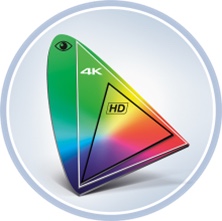4K versus HD in the OR: Is there a difference?
Oh yes, and it’s big.
If you’ve been a surgeon for a while, you probably remember what a game changer moving from standard definition to high definition (HD) turned out to be. It was the crucial technological innovation that helped you and other surgeons advance the possibilities of minimally invasive surgery. And it pushed those unwieldy CRT TV monitors into the dumpster.
Now 4K ultra-high definition (UHD) is set to kick HD to the curb and become the new gold standard in imaging. That’s true in both in the consumer sphere—if you shoot video on your smartphone, you’re probably already using UHD—as well as the surgical suite.
Just as HD did in its heyday, 4K will revolutionize how you operate in the OR. It will also keep your facility on the cutting edge of technological advances, with imaging improvements that improve procedural efficiency, patient safety, and surgical outcomes.
To understand the difference between 4K and HD, we need to look at three key distinctions that radically set them apart: light, color and resolution.
1. Light - Arguably, one of the best things about the Olympus 4K UHD system is its ability to deliver clearer images in all light conditions which allows substantially more light in a 5mm scope compared to 10mm HD laparoscope.

Extra-low dispersion glass: The ED glass lenses in a 4K telescope are optimized for UHD imaging to allow more light across a wider spectrum of colors to be passed to the sensor, reducing chromatic aberration (essentially, distortion caused by varying focal points for different wave lengths). The result: bright, razor-sharp, high-contrast images.
ED glass > Normal glass
OptiContrast LCD panel: Direct lighting in the OR can cause glare and reflections on the display. The OptiContrast LCD features a unique layered construction to minimize internal reflections. And an anti-reflective coating on the display reduces external reflections to ensure clear images during surgery.
OptiContrast panel > Conventional monitor panel
Back-illuminated sensor: The Sony Exmor R CMOS sensor uses back-illuminated technology to double its light sensitivity and reduce image noise by half.
2. Color - The visible spectrum—namely, the color you can see with the naked eye—sets the bar for visualization. Olympus 4K has 1 billion colors compared to 16+ million colors with traditional HD.

With the advent of 4K technology (BT 2020 Colorspace), devices are getting closer to emulating the human eye. This enables rich color reproduction and providesmore subtle differences in red and yellow colors than conventional HDTV. Those differences can help you better detect fine structures that may have you saying, “I’ve never seen that before.”
Wider color gamut > Normal color gamut
With the assured migration to big screen surgery, the next big question before us is discovering what new surgical possibilities 4K will enable in the decade ahead.
3. Resolution - As its name implies, 4K offers a whopping four times the resolution of HD allowing viewing near microscopic level.

Put another way, a 4K image has quadruple the number of pixels (the dots that make up a digital image) per square inch compared to HD. So you have a lot more “data” to work with if you enlarge the size of the image or zoom in to magnify it, all with little to no loss in clarity.
For the aging actor, retention of fine details in a close up might be greeted as bad news, but in the operating room, clarity is king.
Big screen surgery: The resolution of 4K fills a 55-inch monitor with amazingly sharp detail. The image can be seen from across the room or up close for an immersive experience and better team collaboration and efficiency.
High-resolution magnification: 4K allows close observation of fine patterns and structures on the mucosa. Even when enlarged by 2.0x zoom, 4K delivers an image that is crystal clear sharp.
Want to know more about 4K trends in the surgical space? Get linked to upcoming articles by signing up for our email notifications below.


































